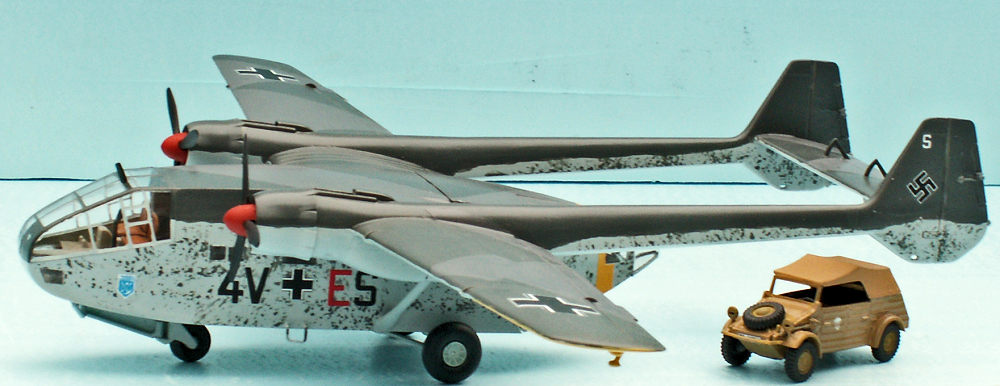
Italeri 1/72 Go-244
| KIT #: | 111 |
| PRICE: | $20.00 on sale |
| DECALS: | Three options |
| REVIEWER: | Torben Plesberg |
| NOTES: | First twin boom transport aircraft in the world |

| HISTORY |
The Luftwaffe was always short of transport aircraft/gliders. The Gothaer Waggon Fabrik developed a transport glider in the early forties called Gotha Go 242, which could accommodate 23 fully equipped troops. It was a shoulder wing steel tube, fabric and wooden construction with a square cross section central fuselage and with a twin boom tail. The glider tug would typical be a Ju 52/3M or a He 111.
When France was occupied in 1940, large stocks of Gnome- Rhône engines were
available for the German aircraft industry. The Go 242 was hence equipped
with two Gnome Rhônes, one in front of each boom. This engine was produced
in counter rotating pairs, a good measure for a twin engine aircraft. The
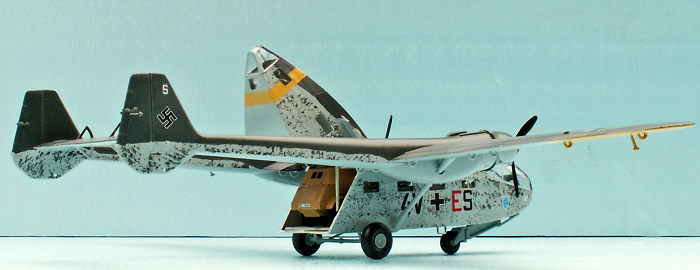 American
P- 38 Lightning had also counter rotating engines as standard. Other German
aircraft with Gnome Rhône power plants were: the Henschel HS 129 anti tank
and close support aircraft, the Messerschmitt Me 323 Gigant, and the Arado
Ar 232 B, both transport aircraft.
American
P- 38 Lightning had also counter rotating engines as standard. Other German
aircraft with Gnome Rhône power plants were: the Henschel HS 129 anti tank
and close support aircraft, the Messerschmitt Me 323 Gigant, and the Arado
Ar 232 B, both transport aircraft.
The Go 244, as the engine version of the Go 242 was called, could carry the same as the glider on own power. The Go 244 was put into production in early 1942. However, the aircraft was a disappointment, because with one engine shut down, it could not maintain height, meaning that the aircraft was underpowered. Besides, it was vulnerable to ground fire.
The service debut of the Go 244 was in Greece, Crete. Other units were equipped with the type in North Africa and on the Eastern Front. However, all aircraft were withdrawn during 1942 because of the shortcomings, and the Go 244s were rebuilt to glider configuration, Go 242. Some 200 planes were produced by the Gothaer Waggon Fabrik. This factory produced large bombers during WWI, and probably, it is best known for its advanced jet fighter plane: the Gotha Go 229 designed by the Horten brothers. Experts today claim that this aircraft was 40 years ahead of its time, being in fact a stealth plane!
| THE KIT |

The
decal sheet has three options, the Go 244 is an aircraft of the TG 3 (Transport
Geschwader 3), the
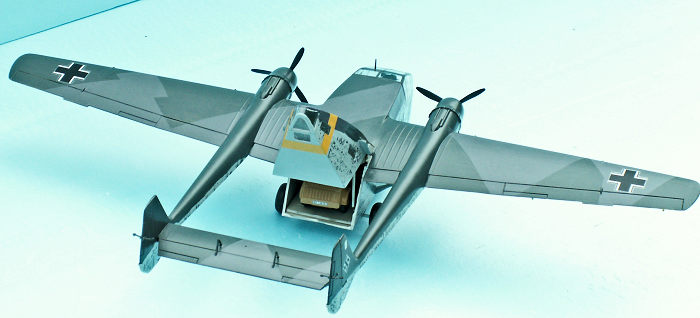 third
transport wing. The decals are easy to apply and the quality is first class.
There are no swastikas with the decals. The size to be applied is a rather small
one: 6 mm. On a You Tube video of the Go 244 there are episodes with the 4V + ES
clearly showing the small size of the swastika. The only difficult item during
the construction would be to make the opening of the rear fuselage workable.
third
transport wing. The decals are easy to apply and the quality is first class.
There are no swastikas with the decals. The size to be applied is a rather small
one: 6 mm. On a You Tube video of the Go 244 there are episodes with the 4V + ES
clearly showing the small size of the swastika. The only difficult item during
the construction would be to make the opening of the rear fuselage workable.
The Special Edition kit was released in 2012, the reason for this was the 50 years anniversary of Italeri. The kit was exactly like the original kit released in 1974, with the exception that the decal sheet was without swastikas!
| CONSTRUCTION |
It
is rather easy to assemble the model. The parts fit very well together and
only very little filling and sanding is needed. The interior of the cockpit
is sparse, however, there is what you can expect. The interior color is RLM
02 Grey. Before the fuselage halves are glued together, all of the windows
were glued in place with clear varnish, nose weight was added, and the
problem with a proper hinge for the opening of the rear fuselage must be
solved. The plastic pins of the hinge are too weak, and might probably break
af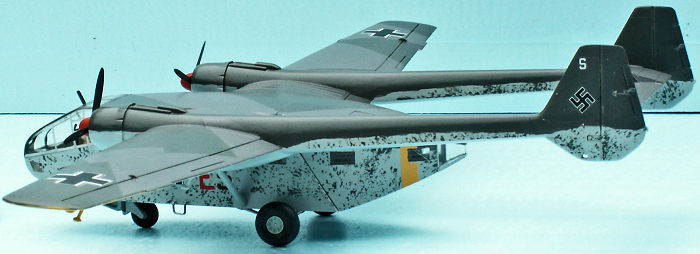 ter
opening and closing the rear fuselage a couple of times. I replaced the
plastic pins with some brass wire. The holes for the wire must be drilled
very carefully and exactly in the position of the plastic pins. This
operation was the most time consuming part of the construction, which
otherwise was a piece of cake.
ter
opening and closing the rear fuselage a couple of times. I replaced the
plastic pins with some brass wire. The holes for the wire must be drilled
very carefully and exactly in the position of the plastic pins. This
operation was the most time consuming part of the construction, which
otherwise was a piece of cake.
I chose to make the motorized Go 244. The Kubelwagen was an extra of the kit, and a good one, because when standing at the aircraft, it gives a good impression of the size of the Go 244. Some of the small parts are very fragile, the foot steps under the doors, and the mass balances of the ailerons. I had to change these parts with scratch built metal parts. The undercarriage is rather special. It does not look like anything I have seen before. The model needs some weight in the nose to avoid tail sitting. The instructions suggest 6 gram, however, I put 10 gram beneath the cockpit floor.
| COLORS & MARKINGS |
Before the
painting, all windows were covered with Tamiya tape, and the canopy and the tail
cone were masked. The color scheme is standard Luftwaffe: Undersides and sides
of the fuselage and booms light blue, RLM 76 Model Master. Upper sides a
camouflage pattern with two grey colors: RLM 74 and RLM 75, Model Master, too.
There is a yellow band around the rear fuselage, RLM 04 yellow. The mottled
effect on fu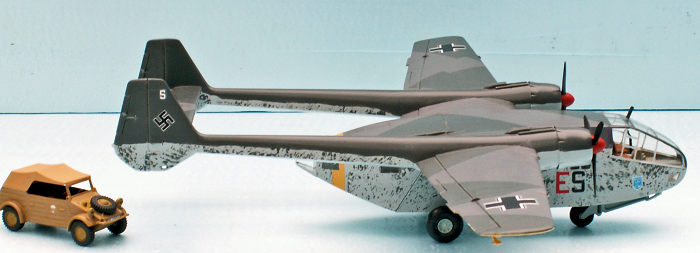 selage,
boom and fin sides was made with a small piece of coarse foam, which was painted
with RLM 75 and then pressed against the areas to be mottled. This trick worked
very well, and only a few touch ups were necessary to make it look quite right.
The Kubelwagen was painted with middle stone HB 225, and a mixture of HB 186
brown an HB 103 cream to make a light brown color.
selage,
boom and fin sides was made with a small piece of coarse foam, which was painted
with RLM 75 and then pressed against the areas to be mottled. This trick worked
very well, and only a few touch ups were necessary to make it look quite right.
The Kubelwagen was painted with middle stone HB 225, and a mixture of HB 186
brown an HB 103 cream to make a light brown color.
The decals worked well, and the only problem was to get some suitable swastikas. However, a sheet with swastikas from Xtra Decals solved this problem. As mentioned: a small swastika should be applied, not a much larger one, as you might have expected, if you have done Luftwaffe models. The aircraft and the Kubelwagen finally got a layer of Satin Cote from HB to protect the decals and provide a nice finish to the models.
| CONCLUSIONS |
The Italaerei kit of the Go 242/244 is recommended warmly for all modelers, who fancy the Luftwaffe or simply twin-boomed aircraft. It is not a well-known type of aircraft, however, as the first of its kind – a twin-boomed transport plane –it makes up a very interesting model.
| REFERENCES |
Wikipedia articles: Go 242 and Go 244. The Go 244 article has a rare color photo of this plane.
On You Tube, there are some relevant videos with the Go 244, original films from the Luftwaffe.
Back to the Main Page Back to the Previews Index Page
Back to the Previews Index Page